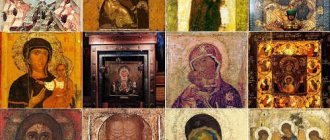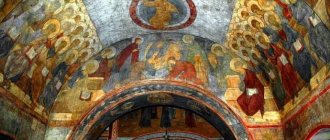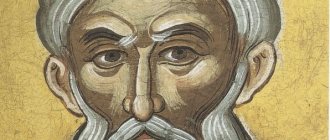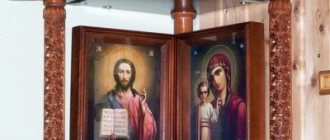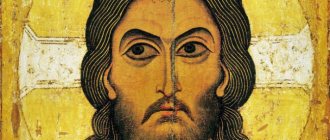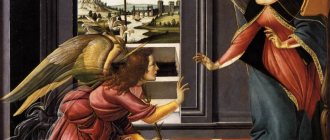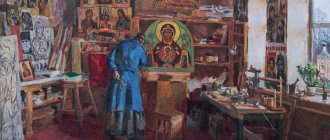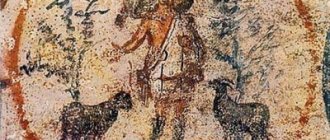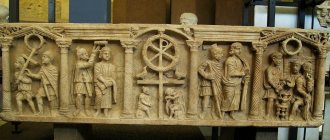Voloshin Maximilian Alexandrovich
Genuine talent is often multifaceted. Constrained by the boundaries of one expressive instrument or creative genre, it goes beyond them and embraces other types of aesthetic self-expression, being realized everywhere with maximum completeness. It was precisely this multifaceted talent that Maximilian Alexandrovich was endowed with. A comprehensively erudite, broad-minded person, a wonderful poet, highly professional translator, art and literary critic , Maximilian Voloshin is also known as an artist with a very extraordinary and original talent.
Maximilian Alexandrovich's contribution to Russian culture, its preservation and enhancement in the difficult and cruel years of the first third of the twentieth century remains to a certain extent underestimated. This whole person, who surprisingly harmoniously combined in his worldview the spiritual philosophy of the East and the modernist quests of the West, not only constantly replenished the cultural treasury with new poetic works, articles, translations, but also created in his home in Koktebel a unique creative and friendly atmosphere that attracted many here the best representatives of the Russian intelligentsia. Nikolai Gumilyov and Marina Tsvetaeva, Osip Mandelstam and Mikhail Bulgakov, Alexey Tolstoy and Vladislav Khodasevich, many other “pilgrims”, saturated with the amazing aura that reigned here, received a powerful impulse for new creativity, and rested their souls from the heaviness and pain caused by the cataclysms occurring in the country.
Our hero's creativity as an artist is inseparable from his creativity as a poet. Maximilian Aleksandrovich’s poems are exceptionally picturesque, full of bright color epithets, colorful and “visible” imagery. And his watercolor landscapes are like strict and precise poetry. They carry a strong meditative impulse, in tune with the works of masters of traditional Japanese fine art. Nature on them is perceived as a perfect divine creation, filled with the beauty of lines, harmony and grandeur. The deep contemplation and detachment of Voloshin’s watercolors, their saturation with light, wisdom and love are primary in relation to the tools for transmitting internal impulse - line and color. The sea and sky, hills and clouds, preserving their density and texture, seem to be superimposed on some universal energy ether, from which once upon a time, at the beginning of time, all primordial matter was born.
Maximilian's philosophical mindset and ability to carefully analyze and summarize the facts of history and the life of society allowed him to foresee the upcoming trials of Russia in advance. He accepted them as a given, with patience and wisdom. During the years of revolution and civil war, Voloshin refused to emigrate and remained in his home in Crimea. He had no one to escape from and nowhere to go. Rejecting all violence and valuing human life above all else, Maximilian Voloshin more than once sheltered fugitives in his house who were in mortal danger, regardless of which political camp they belonged to. Under Soviet rule, Maximilian Aleksandrovich’s house was preserved; he was engaged in the protection of artistic and cultural values, gave lectures, taught, but any possibilities for printed publications were completely closed to him.
Maximilian Alexandrovich’s extensive creative heritage includes not only his talented poems and wonderful watercolors. Numerous critical and art criticism articles, voluminous and very informative correspondence with many of the best representatives of the cultural intelligentsia of Russia are of great interest to everyone who cares about Russian literature, fine arts, culture and history of our country.
On the site you will find a biography of the artist, a gallery of photographs , a large collection of drawings , watercolors , critical articles , memoirs , and poems. The work published on the website about V.I. deserves special attention. Surikov , which Voloshin wrote in 1913, but which to this day remains one of the most in-depth studies of the artist’s work.
We will be glad if the site can unite fans of Maximilian Voloshin’s work, help them find each other, exchange opinions and materials. Write your comments and suggestions in the guest book .
| The echoing bays of a remote and ancient land. | Wary land (Voloshin M.A.) | Spain. Landscape with cypress trees. |
Michelangelo Merisi da Caravaggio
Many facts about Caravaggio's biography are known only approximately, based on later descriptions of the artist's biographers. However, documented events and the very work of this remarkable master of painting allow us to unequivocally state that Caravaggio was a very bright and extraordinary personality. Along with a unique talent that helped the artist create outstanding paintings, Caravaggio was endowed with an extremely complex character, which regularly plunged him into the most dangerous alterations. The painter’s life path is worthy of a separate exciting book, in which creative ups and achievements coexist with duels and chases, and knighting is followed by prison, escape and wanderings in different cities of Italy.At the age of four, the future artist was left without a father, who died of typhus. After training in the Milan workshop with Simone Peterzano, Caravaggio went to Rome. There he lived in poverty for the first time, doing odd jobs and adding individual details to paintings by more famous masters. The turning point in the painter’s fate was his acquaintance with Cardinal del Monte, who not only provided Caravaggio with shelter and board, but also helped him receive his first serious commission. The next few years were perhaps the most successful in the artist’s life. He carried out orders for very prestigious works. His fame grew, although not everyone perceived Caravaggio’s work with unambiguous approval.
The works of the artist Caravaggio indeed differed significantly from the generally accepted examples of painting at that time. Instead of idealizing the image, usual for religious subjects, Caravaggio painted the heroes of his canvases with maximum naturalism. The ancient gods, Christian saints and martyrs in his paintings became real people, demonstrating a pronounced individuality and democratic simplicity of personality. The depiction of the human body in all its naturalness and stubborn admiration for the truth of life did not always contribute to mutual understanding between the painter and his clients. Some of his works were rejected by buyers due to their “indecency,” which did not prevent Caravaggio, who had already received wide recognition among the enlightened public, from successfully resell his works to other connoisseurs of his talent.
During the Roman period, Caravaggio's original painting system was almost completely formed. The brightly lit foreground was shaded by the background, which created the optical effect of bringing the action taking place in the picture closer to the viewer. All details, even minor ones, were surprisingly tangible and were drawn with the utmost care. The plots themselves were often filled with deep inner drama, producing an exceptionally strong impression. With his work, the artist completely rejected the division of painting genres into “high” and “low”. He made a significant contribution to the development of new directions for art of that time - the everyday genre and still life.
However, the violent temperament of the artist Caravaggio, his audacity and lack of restraint constantly became the cause of great trouble. He went to prison several times. His offenses included throwing a tray at a waiter, carrying a weapon without permission, and breaking his landlord's windows. Finally, one of the random duels ended in murder, and Caravaggio was forced to flee Rome. In the remaining four years of his life, the artist had to constantly move from place to place. From Naples he moved to Malta, where he was first knighted, and then, after another heated quarrel, again imprisoned. Having made a daring escape, Caravaggio returned to Naples. Here he awaited pardon and permission to return to Rome. But, having received forgiveness and boarded the ship, the artist contracted malaria and died at the age of thirty-seven.
To better understand Caravaggio’s work, you need to visit Italy. If you are lucky enough to get to Florence, be sure to visit the Uffizi Gallery.
Our website presents both the life story of the creator and some analysis of his technique and paintings.
In Russia - in the St. Petersburg Hermitage - there is one painting by Caravaggio, Youth with a Lute.
We will be glad to receive any new materials about this amazing artist.
Diego Velazquez
Magnificent, mysterious, incomprehensible, more vital than life itself - this is how researchers characterize the work of Diego Velazquez.
Velasquez was incredibly lucky. A court painter who spent his life in communication with monarchs, who had the opportunity to travel and admire the most beautiful treasures of world art, he was treated to fame during his lifetime, receiving well-deserved recognition not only from the royal family, but also from other painters of his time. And this despite the fact that he managed to achieve the greatest truthfulness in his works, without flattering anyone, even the most powerful persons of this world. Velazquez receives such exceptional recognition well deservedly. Gifted with extraordinary talent, the artist hones his skills throughout his life and, thanks to extreme hard work, eventually reaches the highest creative peaks.
Early creativity. Seville period: 1617 - 1623
The individuality and originality of Velazquez is already evident in the early work of the painter, which includes the Seville period - 1617 - 1623. The canvases of this period were created in the bodegon genre (translated from Spanish as a tavern or tavern). These paintings usually feature several half-figures in domestic kitchen scenes or at meager breakfasts. These are mainly representatives of the common people, in whose depiction one can already see the realism of the image so characteristic of Velázquez. The most famous paintings of this period include the paintings “Breakfast”, “The Old Cook”, “Breakfast of Two Young Men”, “The Water Carrier”. As well as his early religious paintings: “Christ in the House of Martha and Mary”, “Adoration of the Magi”. They are characterized by a dark palette of colors, a dense and heavy manner of depiction, and sharp black and white contrasts. They do not yet have that synthesis of color and volumetric forms, reflections and shadows, skillful depiction of the light-air environment that distinguishes the master’s later works. These paintings are more remarkable for their masterfully thought-out composition, intriguing selection of colors and shades, and subjects in which the life of ordinary Spaniards is depicted with sincere respect and warmth.
Madrid creative period: 1623 – 1649
The years of his stay in Madrid contributed to the significant improvement of Velázquez's skill and the development of coloristic techniques. During these years, Velazquez gets the opportunity to study the treasury of the king's painting collection, has the opportunity to communicate with the Spanish cultural elite, and travels to Italy for the first time, which helps expand his artistic horizons. During this period, “antique” canvases, extremely unusual for Spanish painting, were created: “Bacchus or the Drunkards”, “The Forge of Vulcan”, with their characteristic irony and life-like authenticity. In them, the master extremely unusually combines a mythological plot with common everyday scenes, thereby synthesizing mythology and the real life of his time. So Velazquez's Apollo looks like an ordinary street rake, despite his divine attributes. The color palette in these paintings is extremely interesting, synthesizing the finest color shades that give the fragments of the painting extraordinary beauty. These tonal shades tie together individual fragments and add an unusual zest to the composition of the canvas, as do the luxurious colors of the silk lilac-pink cloak of Bacchus, embedded in the monotonous brown-gray background. ("Triumph of Bacchus").
A special place in the artist’s work is occupied by his only monumental painting in the genre of historical painting – “The Surrender of Breda”. This picture can be called a timeless canvas, because the philosophical plot depicted on it - the dialogue between the winner and the vanquished, could be inherent in any time and people. The nature of the work also breathes its own special philosophy. With its majestic calm, it reflects the eternal inviolability and equanimity of the universe, which is not worried or affected by human passions.
First trip to Italy: 1629 – 1631
During this period, Diego Velazquez continued to get acquainted with the treasures of world painting: the work of Van Dyck, Leonardo da Vinci, Venetian colorists - Titian, Tin Toretto, Paolo Veronese, Michelangelo, and made copies of their paintings. These observations introduce new touches of skill into his work - naturalness and charm in the depiction of characters, especially children, a masterful rendering of space and light-air environment. Velazquez's stay at the Villa Medici gives life to the wonderful landscape "Garden of the Villa Medici", where this magnificent architectural structure and the surrounding nature are depicted in the golden colors of the approaching sunset.
Portraits 30 – 40 years
Since Diego Velazquez was a court painter, during his life he painted a huge number of portrait works. But even in the most ceremonial images, he managed to breathe life and genuine truthfulness into the image. And this despite the fact that gesture, movement and individual accessories are absent in his portraits. And yet, his paintings are filled with life due to the airy background, the finest synthesis of colors and the effects of color combinations. The content side of the master’s portraits is also extremely interesting. Whoever Velazquez portrays, starting from the king and the most powerful persons of Spain, he portrays his heroes as they are, with the subtlest psychologism, conveying through appearance the inner individuality of the image, the character of his characters.
When, on his second trip to Italy, he portrayed the head of the church, Pope Innocent X, he so masterfully portrayed the inner toughness and cunning of his hero, while realistically describing the luxurious surroundings that surrounded him, that the pope had every reason for his famous comment: “Too true.” " But Velázquez’s portraits will be remembered by posterity not only for the depiction of the royal family and court nobility, but also for the portraits of the “orphan and offended” - royal dwarfs and jesters. In them, the master with the greatest sympathy conveys the tragedy of people offended by life and fate. People, sometimes smart and talented, aware of the whole drama of the contradiction of their inner spiritual content and external ugliness, or truly blessed ones who cannot understand the tragedy of their fate.
Second trip to Italy: 1649 – 1651
By the time of his second trip to Italy, Velazquez’s artistic taste, so contrary to Italian academicism, had finally taken shape. The portrait of his assistant Juan Pareja brought Velazquez such a triumph that Roman artists elected him a member of two academies. During this period, in addition to the famous portrait of Innocent X, he also painted portraits of some people from the papal circle.
Late period: 1650s
At this time, Velazquez reaches the heights of his mastery.
This period includes portraits of women and children of members of the royal court: Queen Marianna of Austria, Infanta Maria Teresa, Infanta Margarita, Infanta Philip Prospero, and a portrait of the aging Philip IV. And, of course, the most famous paintings by Diego Velazquez “Las Meninas” and “The Spinner”. The painting “Spinners” seems to continue the theme of Velazquez’s early mythological paintings, where there is a striking synthesis of mythological mysticism and contemporary realities of the artist. The master gives his own interpretation of the ancient myth, poeticizing the beauty and greatness of human labor and talent. His painting “Las Meninas” influenced the subsequent creation of paintings of the everyday genre. The plot of “Las Menin” is not just a group portrait of members of the royal court. The painting is distinguished by its most complex composition, in which Velazquez, thanks to his greatest technical skill, creates a complete sense of the real life of the characters and all the fragments of the canvas, asserting with his talent the true apotheosis of pictorial art. In this picture and in many of his creations, Velazquez was far ahead of his time and surpassed the achievements of many of his predecessors and contemporaries. He surpassed them both in his greatest technical skill, in his boldness in depicting the characters, and in his artistic design. After all, it was his brush that painted the portrait of a naked woman in the painting “Venus with a Mirror” - an audacity unheard of during the times of the harsh Inquisition, the rarest image of a nude in the history of Spanish painting. The widest coverage in the works of the master of various layers of social life in Spain in the 17th century is striking, showing the contrasts of nobility and poverty, folk life and the life of aristocrats. The artist's skill reaches such a level that the most complex technical techniques merge into one whole, becoming invisible to the viewer and leaving only an indescribable feeling of fascination with the picture. It is probably impossible to fully convey in words the magical charm of Velazquez’s paintings, but one thing is certain – the mysteries of the incomprehensible mastery of the great Spanish painter’s work will always excite true connoisseurs of authentic art.
We will be sincerely glad if you leave your reviews, wishes or comments about the site in its guest book.
| Atlanta of the Hermitage | Hermitage Winter Palace | Francisco Pacheco |
- A film about the life and work of the artist D. Velazquez.
- Velazquez Art Gallery
- Chronology of the life cycle of D. Velazquez
- Velazquez's feminine nature
